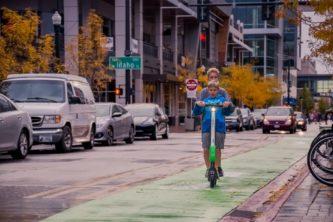By James Carter
The new-fangled world of micro-mobility is one that seems to have the transportation industry buzzing, with record user growth rates and even more dizzying company valuations. It’s not without good reason either. Micro-mobility, which could easily be just described as small personal transportation devices, like bicycles, scooters and everything in-between, has been greatly enabled by electrification and app-based sharing, which has unleashed all sorts of new innovative business models.
The premise makes complete sense. Why take a car in a dense urban setting when a small device that consumes far less energy and space can be used instead? The low vehicle cost and low operating cost means trips are cheap, effectively a great enabler for those with lower incomes. It also addresses the problem of “first and last mile” — getting from major transit routes to home or work and vice versa. These enablements, plus the convenience of having a mobility solution close by wherever you are, especially with dockless devices, makes for a very enticing mobility solution.
Fun to ride
Another aspect about micro-mobility, and scooters in particular, is that they’re fun to ride. In our annual Mobility Study, published last year, we found that it’s easily the No. 1 reason to ride a scooter. Fully 25% of respondents who ride scooters cited this factor, and it is likely a key attribute propelling their record growth.
It’s this idea of fun — plus the efficiency, convenience and urban suitability — that proponents rightly key in on and promote.

However, micro-mobility solutions as a whole have a bunch of problems. They are open to vandalization and abuse, can’t be used in poor weather (especially unsuitable for cold winters), and have an unsavory habit of bringing out anti-social rider behaviour. As well, electric bikes and scooters need to be charged, which is especially problematic for dockless business models where scooters can be left almost anywhere.
But dangerous, too
Scooters have another unique and far reaching problem — safety. Technically, it would be defined as high levels of instability due to a combination of short wheelbase, small wheels and high centre of gravity. In short, most scooters are dangerous because they’re hard to control and easily tripped up. Take a quick look at the design and riding position of a scooter and it’s easy to figure out: riders stand with their feet just behind a tiny front wheel.
Add to that a top speed of up to 25 kilometres per hour and almost no helmet usage, and it’s no wonder that injuries from scooter accidents often result in severe trauma, particularly head injuries. Two studies, one done by Austin Public Health and supported by the U.S. Center for Disease Control in Austin, Tex., and the second by the New Zealand Medical Journal, showed that injuries sustained are often similar to severe car accidents. In fact, the CDC study showed the rate of injuries in the U.S. per given distance covered were around 27 times higher than for cycling — in a country known for very poor cycling infrastructure and much higher cycling injury rates than in Europe.
E-scooter design needs to be safer: bigger wheels, better brakes, suspension, a longer wheelbase, wider deck
James Carter, Principal Consultant, Vision Mobility
For any safety advocate and concerned citizen this is a disastrous situation, and one that micro-mobility companies gloss over. They point to the fact that there are many more car accident injuries and deaths; of course, conveniently ignoring that car usage is many, many multiples higher than scooter usage. It’s like saying that base jumping and free climbing El Capitan is safer than driving your car because there are fewer total injuries and deaths from people doing these activities.
Public anger
Micro-mobility, especially scooters, has also proven to have a unique ability to create public anger and consternation. There are plenty of videos of pedestrians getting hit by inattentive scooter riders, scooters being left strewn on foot paths and blocking entranceways and generally giving the city an untidy look. Even if these things don’t result in injuries, they sure arouse strong feelings among citizens; for elected officials, supporting such activities could be the kiss of death. Already, more than a few cities have banned scooters and more again are taking plenty of time to think about appropriate introduction and rollout.
On a visit to Washington, D.C., earlier this year, I took the opportunity of the well-stocked micro-mobility scene to take a couple different options for a spin. The first was a Bird scooter. It was, by any practical measure, truly appalling to ride. Terrible ride quality made my face shudder over the smallest bump, pavement joints became major obstacles and braking was almost non-existent. I had to keep my eyes peeled for unexpected obstacles like tree roots or broken pavement, as well as unaware pedestrians. The riding position also felt quite unstable — I knew that if I got in to trouble, I was down and hurtin’ bad.
Scooter vs. bike
Having said all that, cruising Washington’s National Mall on a warm spring day on a scooter was a delight. It was fun, as our survey indicated, almost like being transported upright to the next sightseeing adventure.

Jumping onto a Jump e-bike straight after was a revelation. Greatly enhanced power, stability and braking made it much safer to ride, even if the brake’s effectiveness were no match for the hydraulic discs on my mountain bike. I could safely jump curbs and unexpected 4-inch high obstacles were never a problem. The pedal activated e-motor rocketed me ahead from a standstill and it didn’t take long to hit the maximum speed of more than 30 kilometres per hour. Strangely, I put the e-bike away earlier. Somehow it wasn’t as fun or cool. Was it the styling or riding position? And why were scooter riders out numbering cyclists by about five to one in that area?
Indeed, why are scooters so popular, yet so hated? With twice the growth rate of ride hailing and seemingly five times the opposition, what is next for e-scooters and micro-mobility?
A harmonious service?
Without doubt, there’s more than sufficient demand, and the promise is admirable. Thus, the question that really interests me is how can micro-mobility grow beyond its problematic introduction to truly become a harmonious service to a city and its residents?
To start, both scooters and bikes need to be dropped off in specific areas that represent a tidy solution to the city landscape. This means that they aren’t in the way and not a danger to pedestrians and those with disabilities.

Rider training needs also to be substantially improved, including wearing a helmet. The CDC survey found that a high propensity of accidents involved riders with very limited experience; in cases where riders were hospitalized, more than half the time it was to treat head injuries.
Most importantly, e-scooter design needs to be safer. The current crop of e-scooters are not more than toys, and frankly it’s not a hard fix: bigger wheels, better brakes, suspension, a longer wheelbase, wider deck and a seat would fix just about all the major problems. If that sounds like a mini moped, you’re probably correct. But who wants to ride a moped? Audrey Hepburn’s “Roman Holiday” was a long, long time ago.
Yawning gulf
It’s as though safety and cool need to come together in a harmonious package, and the recent scooter updates by Bird and Lime are laughable. Today, there’s a yawning gulf between these two ideals, and it continues to create all sorts of consternation, anger and, sadly, frequent serious injuries and deaths. The scooter company that figures out what truly is safe and cool, will be an out-of-the-park success. It’s only then that a safe, efficient, last-mile solution can be realized, something that micro-mobility has promised, but not yet delivered.















